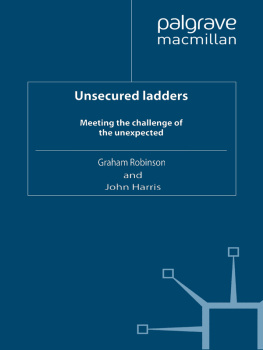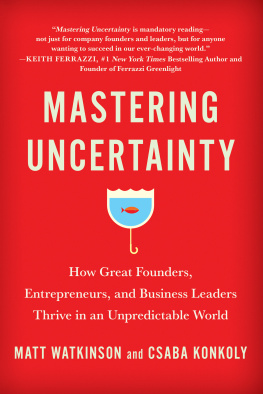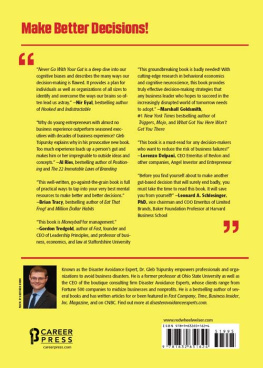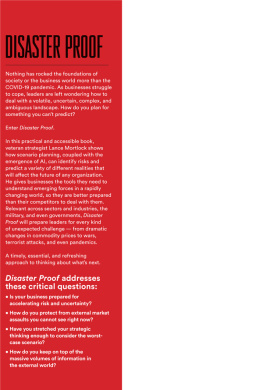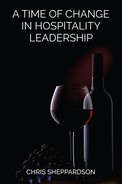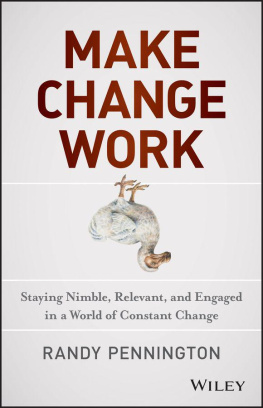Unsecured ladders
Unsecured ladders
Meeting the challenge of the unexpected
Graham Robinson
Visiting Research Fellow, Centre for Management
Learning and Development, University of Surrey
and
John Harris
formerly Chief Executive, Calor Group plc


Graham Robinson & John Harris 2009
All rights reserved. No reproduction, copy or transmission of this publication may be made without written permission.
No portion of this publication may be reproduced, copied or transmitted save with written permission or in accordance with the provisions of the Copyright, Designs and Patents Act 1988, or under the terms of any licence permitting limited copying issued by the Copyright Licensing Agency, Saffron House, 6-10 Kirby Street, London EC1N 8TS.
Any person who does any unauthorized act in relation to this publication may be liable to criminal prosecution and civil claims for damages.
The authors have asserted their rights to be identified as the authors of this work in accordance with the Copyright, Designs and Patents Act 1988.
First published 2009 by
PALGRAVE MACMILLAN
Palgrave Macmillan in the UK is an imprint of Macmillan Publishers Limited, registered in England, company number 785998, of Houndmills, Basingstoke, Hampshire RG21 6XS.
Palgrave Macmillan in the US is a division of St Martins Press LLC, 175 Fifth Avenue, New York, NY 10010.
Palgrave Macmillan is the global academic imprint of the above companies and has companies and representatives throughout the world.
Palgrave and Macmillan are registered trademarks in the United States, the United Kingdom, Europe and other countries
ISBN-13: 978-0-230-22230-4
This book is printed on paper suitable for recycling and made from fully managed and sustained forest sources. Logging, pulping and manufacturing processes are expected to conform to the environmental regulations of the country of origin.
A catalogue record for this book is available from the British Library.
A catalog record for this book is available from the Library of Congress.
10 9 8 7 6 5 4 3 2 1
18 17 16 15 14 13 12 11 10 09
Printed and bound in Great Britain by CPI Antony Rowe, Chippenham and Eastbourne.
To Katie, Daniel, Alfie and Sin who will face the challenges that we shall leave behind.
Graham Robinson
To my wife Frances without whom there would be nothing, and to our daughters Louise and Catherine for being simply the best.
John Harris
LIST OF BOXES
2.1 An ill wind?
2.2 Spot the deliberate mistake
2.3.1 How to appoint directors
2.3.2 Watching for his lips to move
2.4 The call center project
2.5 Symptoms of hubris?
3.1 Tackling the right problem?
3.2 Business as usual?
3.3 A CEOs experience of a takeover bid by a major shareholder
3.4 Consistent messages?
4.1 Remember who you are!
4.2 Dancing on hot coals
4.3 Do you need a crisis?
4.4 Mistakes are made by people not by procedures
4.5 Who was the doctor?
4.6 Fire! Fire!
5.1 Identifying your values
5.2 Credit crunch values
5.3 Values 1
5.4 Values 2
5.5 Values on the line
5.6 Recurrent paradox
6.1 The operations directors nightmare
6.2 Rethinking the business 1
6.3 Rethinking the business 2
6.4 Is everyone on board?
6.5 Taking people decisions
6.6 Growth at all costs
7.1 A post-credit-crunch world
LIST OF FIGURES
7.1 The organizational pyramid
7.2 A classic organogram
7.3 Flatter structures, reduced hierarchies
7.4 The organization in two dimensions
7.5 A birds eye organogram?
7.6 Some typical networks of a CEO
ACKNOWLEDGMENTS
Much of this book is concerned with asking questions. It could not have been written had not Geoff Armstrong, Paul Breach, Mike Brown, James Espey, George Gater, Michael Hind, Mike Kirkman, Jeremy Meyrick-Jones and, above all, John Harris permitted me to ask them impertinent questions over the course of several years as each of them addressed the consequences of unexpected events impacting themselves and their organizations. In Johns case, the questioning process went on as we wrote the book together and continues to the present day.
My thanks are due to them all, as well as to Arie de Geus and Peter Honey who generously read and commented on early versions of the text, to Stephen Rutt and the team at Palgrave who have knocked it into shape and to my wife, Sandra, without whose encouragement I would not have completed my research and who frequently reminds me that answers are important too.
Graham Robinson
Over the years I have been immensely lucky to meet and work with many wonderful people who, by either being a role model or by giving me their time, have shown me how to get the best out of myself and others. There have been so many that it is impossible to thank them all by name, but I would especially like to single out Norman Roberts, Ronnie Pickering and Peter Shaw.
Huge thanks must go to Graham for his patience, great ideas and hard work; without him there would be no book and to Stephen Rutt and all at Palgrave for their encouragement and guidance.
Finally in addition to thanking all my family for their guidance and support, I must give special thanks to my grandmother. She handled the most unexpected event of her life with stoicism, courage and love and gave me my enduring values.
John Harris
CHAPTER 1
Introductions and a problem
1.1 Whats the big idea?
Just who is responsible for the current mess in which we find ourselves? People like us; like you and like me. Thats uncomfortable.
Just before we finished writing this book in December 2008, the worlds banking system was edging back from the brink of collapse with what looked like the reluctant assistance of governments. Several leading banks did not make it. Stock markets tumbled one day, recovered the next while the dollar and the pound weakened against the euro before the pound went on to weaken against both. A global recession, if not a fully fledged slump, was imminent. Business leaders (especially bankers) were held in ever decreasing esteem as credit dried up and company after company from Wall Street to Main Street was driven to the wall. Numerous pundits appeared in the worlds media to declare that what was happening had been entirely predictable. Yet many company boards, their CEOs and directors seem to have been taken completely by surprise and suffered the consequences.
Bankers at the center of the storm denied that they had any responsibility for the crisis in which we all now find ourselves. Both Richard Fuld, the former chief executive of Lehman Brothers, when questioned by a congressional committee, and Adam Applegarth, who had been CEO at the UKs Northern Rock bank, when quizzed by a group of British MPs, claimed that the circumstances that caused both banks to fail could not have been predicted. Therefore, they concluded, they were in no way responsible for what had happened. Fuld stated that night after sleepless night he had racked his brain to see if he could think of anything that he might have done differently and said that he could think of nothing. Applegarth made similar claims to the effect that what had happened had been totally beyond his control.
So why, we wonder, had Fuld been seeking to find a buyer for Lehman Brothers in the weeks before it went bust?

